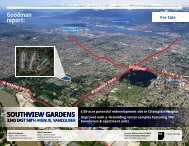Canada
MER-Canada-2016
MER-Canada-2016
You also want an ePaper? Increase the reach of your titles
YUMPU automatically turns print PDFs into web optimized ePapers that Google loves.
CHAPTER 3. LEGAL SYSTEM AND OPERATIONAL ISSUES<br />
129. While the CBSA may investigate fiscal crimes, it does not have the powers to investigate<br />
related ML/PPOC cases, and in instances where it considers that there are reasonable grounds to<br />
suspect that a person is or has been engaging in ML activities, it reports the case to the RCMP. The<br />
latter recorded that between 2010 and 2014 there were 444 ML/PPOC occurrences related to cross<br />
border currency reporting. The authorities provided one case (“Project Chun,” described in the Box<br />
below) of a successful ML investigation started in 2002 on the basis of a CBSA referral. Whilst the<br />
assessment team was also shown several ML cases involving parallel investigations arising from<br />
CBSA’s enquiries into smuggling or customs related offenses, no other cases arising from CBSA’s<br />
cross-border declaration/seizure reports were provided. It therefore appears that, in practice,<br />
information collected at the border is analysed or investigated with a view to pursuing ML activities<br />
to a very limited extent only. The cross-border declaration system is not adequately used to identify<br />
potential ML activities.<br />
3<br />
Box 4. Case study: Project Chun<br />
In October 2002, a male was intercepted at the Montreal International Airport with USD 600,000<br />
cash in his hand luggage. In the absence of a valid explanation, the money was seized and the case<br />
was referred to RCMP which initiated an investigation to determine the source and destination of<br />
the money. Extensive enquiries unveiled that the male and his wife owned two currency exchange<br />
companies in <strong>Canada</strong> and in 2000 they made an agreement with a drug trafficker to assist the latter<br />
in laundering proceeds deriving from drug trafficking activities. The laundering included use of<br />
various financial services and an elaborate scheme for the transfer of money to a bank in Cambodia<br />
that was owned and controlled by the couple. The precise amounts involved in these activities are<br />
estimated at more than CAD 100 million. Information received from FINTRAC indicated that the<br />
couple dealt in large sums of cash and that their bank account activities did not fit their economic<br />
profiles. Travel records of one of the accomplice money launderers were received from Cuba<br />
through MLAT requests. The accomplice, who was detained in custody in the US, was later<br />
transferred from the US to <strong>Canada</strong> to provide testimony for the prosecution. Canadian investigators<br />
had travelled to Israel and Cambodia for tracing after and restraining the crime proceeds. The<br />
couple applied delaying tactics during the prosecution and the Canadian authorities eventually<br />
convicted the couple with six counts of Money Laundering and seven counts of tax offenses. In<br />
March 2015, the couple was each sentenced to eight years of imprisonment and ordered to pay fines<br />
of CAD 9 million. Two real properties, USD 600 000 and the shares of a bank in Cambodia were<br />
forfeited.<br />
130. <strong>Canada</strong>’s main law enforcement policy objective is to prevent, detect and disrupt crimes,<br />
including ML, but in practice, most of the attention is focused on securing evidence in relation to the<br />
predicate offense and little attention is given to ML, as evidenced by the discussions held as well as<br />
by the case studies provided. LEAs focus on criminal actions undertaken by OCGs (i.e. mainly drugrelated<br />
offenses and fraud). Cases studies and figures provided by LEAs demonstrated that they also<br />
investigate other high-risk offenses (e.g. corruption and tobacco smuggling), but to a limited extent<br />
only. Insufficient efforts are deployed in pursuing the ML element of predicate offenses and pursuing<br />
Anti-money laundering and counter-terrorist financing measures in <strong>Canada</strong> - 2016 © FATF and APG 2016<br />
47




